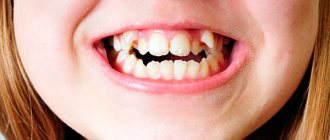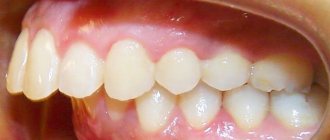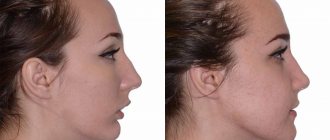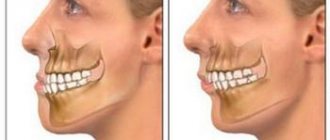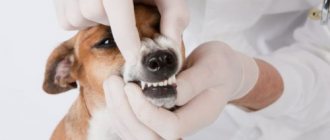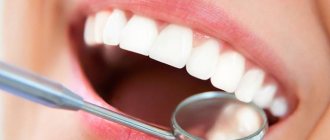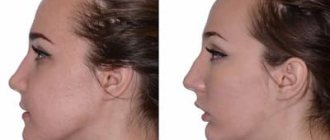Modern dentists pay great attention to correcting bites in children. This approach is due to the fact that in childhood it is possible to achieve the desired result of orthodontic treatment using simpler and more accessible methods; the correction can be completed in a short time. At the same time, if this anomaly is left unattended, the situation will worsen. In addition to aesthetic defects and facial asymmetry, other problems of the dental system will appear, increased wear of teeth, and disturbances in the functioning of the temporomandibular joint.
Stages of bite formation in children
The process of developing a child’s bite can be divided into several important stages.
Each of them is characterized by changes in the structure of the jaw and has factors that influence the formation of pathology. Stages of bite development in children:
- Elementary.
From birth to six months of the child. The first teeth begin to erupt towards the end of the period. The cause of pathology at this stage is a genetic predisposition or improper latching of the nipple during breastfeeding. - The process of formation of the bite of primary teeth.
Lasts until the age of three; as a rule, by the end of the period, all 20 baby teeth are in their position. At this age, the presence of gaps between the teeth is acceptable, but twisting, too close a fit, and growth in an uncharacteristic plane are considered as deviations from the norm. In addition to the above reasons, the most common factor in the development of pathology is bad habits: thumb sucking, pacifiers, toys or eating disorders. The child's diet should include a sufficient amount of solid food. - Preparation for the development of permanent dentition.
The stage continues until the appearance of the first permanent teeth. With proper oral care, no external changes are observed during this period. Bad habits can cause malocclusion. It is necessary to ensure that the child does not chew hard objects: pencils, thick books, furniture, since baby teeth are very soft and easily deformed. - Changing the temporary bite to a permanent one.
The most critical stage. It is during this period that serious pathologies begin to manifest themselves as unpleasant changes: torsion, improper growth of teeth, discrepancy between the size of the jaw and the volume of bone units, etc. On average, this period lasts up to 12 years. Factors in the development of anomalies are physiological characteristics or untimely replacement of teeth. - Formation of a permanent bite.
The teeth complete their growth and occupy a certain position in the jaw.
You can start correcting your bite from the early stages. There are several hardware and manual methods for this. Treatment with braces begins after a permanent bite has formed.
Transition period: mixed bite
The condition of the musculoskeletal system affects the development of occlusion from the moment the child begins to walk. But usually problems with posture appear at the age of 5–6 years, when the child begins to prepare for school, completes assignments and spends more time at the table. At school, these problems can get worse.
The period of changing teeth is the time when dental health for the future is laid.
For example, when you slouch, your shoulders are rounded and your head is pushed forward. Due to the habit of slouching, a distal bite may develop, in which the lower teeth do not meet the upper teeth, and the upper teeth may deviate inward during eruption, forming crowding.
In the same logic, a crossbite can form as a consequence of scoliosis.
Any problems with posture at the age when baby teeth begin to fall out are a risk of malocclusion.
Parents also need to ensure that baby teeth are not removed prematurely. When a baby tooth falls out, it seems as if it had no root at all, but in fact there are roots, but they dissolve by the time it falls out. Until that time comes, the root supports the other teeth and allows the jaw to develop.
If a baby tooth is pulled out too early, the space in the dental arch may become narrower. Then, due to lack of space, permanent teeth may grow crowded.
Therefore, in the case of caries, baby teeth need to be treated and removed only when they begin to become loose.
Signs of malocclusion
For timely detection of maxillofacial defects, it is necessary to regularly examine the baby’s oral cavity. Here are a few signs by which you can identify a malocclusion in a child:
- obvious displacement of the lower jaw outward or inward;
- crooked, uneven teeth;
- vestibular or lingual growth of teeth - in front or behind the main row;
- diastema - spaces between the incisors;
- strong overlap of the lower teeth with the upper ones;
- non-closure of the upper and lower incisors with a formed bite;
- half-open mouth, replacement of nasal breathing;
- speech defects.
Signs of malocclusion
In addition to the visible signs, if you look closely, you can notice abrasion of the enamel on the front or back teeth, and gum injuries. The child complains of tension in the jaw muscles, difficulty chewing or swallowing food, and headache. These signs will help you understand that your child has a malocclusion and seek advice from an orthodontist.
Types of structures for correcting children's bite
- Plates. Removable structures that can be used to move teeth and expand the jaw. Dental plates are easily removed from the mouth, which makes them convenient in everyday life.
- Trainers. Unlike classic braces, these designs can be used on very young patients. Provide comfortable treatment and quick results. Made from silicone. Worn for about an hour during the day and left overnight.
- Mouthguards. An effective way to quickly correct malocclusion. They are almost invisible on the teeth, and if necessary, they can always be removed.
- Braces. Fixed structures, which are installed once and for the entire period of bite correction. Modern braces can be metal, plastic, or sapphire (almost invisible to others). Lingual braces, which are installed on the inside of the teeth and are completely hidden from prying eyes, are very popular today.
Remember, the later you start treating malocclusion, the more difficult, long and expensive your path to your goal will be. You can correct your bite at the age of 50, but you will have to spend much longer time, effort and money.
Types of malocclusion
The curvature of the teeth does not always mean a pathology of the bite, which is understood as the closing of the jaws, ensuring the full, unhindered functioning of the masticatory apparatus.
Among the types of malocclusion in children are:
- Prognathia – distal occlusion.
This is a common reason for visiting an orthodontist in early childhood. The muscles of the lower jaw are not yet sufficiently developed, so outwardly it seems that the upper row of teeth protrudes strongly forward compared to the lower one. With the introduction of hard foods into the diet: hard fruits and vegetables, the problem may disappear without medical intervention. - Progenia – mesial occlusion.
At an early age, this pathology is usually caused by genetic characteristics or improper latching of the nipple during feeding. The sooner the pathology is identified and treatment is prescribed, the fewer negative consequences the child will receive. - Deep bite.
Parents often confuse it with the distal one, however, with a deep bite, the lower jaw does not go back, but seems to sink inside. The upper front incisors overlap the lower ones by more than half. Obvious signs of pathology are speech defects and soft tissue injuries. - Crossbite.
It appears at the stage of replacement of milk teeth with molars. In this case, on the one hand, the upper jaw overlaps the lower jaw, on the other, the lower teeth come to the fore. - Open bite.
With this malocclusion pathology, there is a noticeable lack of closure between the teeth of the upper and lower rows. Most often, this disorder affects the incisors, but it also occurs on the posterior premolars and molars.
Types of Malocclusions
Malocclusions in children are diagnosed during annual examinations. It is important not to waste time and immediately begin preventive or therapeutic treatment.
Moving options
There is an opinion that the tooth is fixedly fused to the jaw bone. This is not entirely true. The root of the tooth is firmly attached to the tooth socket by fibers of connective tissue. These elastic fibers are located in the narrow gap between the bone wall and the tooth root. Teeth are able to move independently during eruption and under the influence of certain forces.
When a slight prolonged pressure is applied to the wall of the tooth socket, it dissolves in this place, opening up “prospects” for movement for the causative tooth. On the other hand, where the fibers of the connective tissue are stretched, new bone is formed, which does not allow the “displaced” tooth to return to its original position
Photos of children with pathological bite
In the presented images you can see the child’s malocclusion. The photo shows various pathologies that are often found in patients with baby or molar teeth. Detailed photographs of children with malocclusion captured in the photo during an orthodontic consultation will help parents in self-diagnosis of the pathology. However, the doctor chooses the effective therapy regimen.
Photo of a girl with an incorrect open bite
Photo of a child with an incorrect deep bite
Photo of a boy with an incorrect deep distal bite
The boy has an open bite
The girl has a deep distal bite
How to correct a child's bite
No matter how severe the pathology, the earlier treatment is started, the easier it is to achieve an effective result. To correct violations, there are three ways to correct bite in children:
- traditional – installation of braces;
- alternative (without braces) – mouth guards, plates, physiotherapy;
- cardinal – surgical intervention.
Until the final stage of permanent bite formation, only alternative methods are used, but is it possible to correct a child’s malocclusion with their help?
Removable orthodontic plates
Orthodontic plates
are structures consisting of a polymer jaw-expanding base and metal arches that serve to fix the plate and align the front row of teeth.
Removable orthodontic plate
These devices are made individually, based on casts of the jaw of a small patient. To adjust the load, the devices are equipped with screws and expanders. At an appointment with a doctor, the child’s parents will learn how to perform this procedure on their own, which will save time on visits to the orthodontist.
Plates for correcting malocclusion in children are designed to be worn constantly, but the removable structures are removed during meals or hygiene procedures.
Trainers for teeth
Trainers
To correct malocclusion in children, they are mouth guards made of dense silicone.
Trainer for correcting the bite
The trainer performs several functions:
- Self-corrects minor pathologies.
- Prevents further development of malocclusion and prevents complications.
- Helps get rid of bad habits that have caused crooked teeth.
Mouth guards for correcting malocclusion in children fix both jaws simultaneously in the correct position. But when using them, it is impossible to lead a normal lifestyle: talking, eating. Therefore, mouthguards are worn while the child is sleeping and for several hours during the day.
The process of correcting a bite with trainers is long and requires patience from the child and parents.
It has been noticed that in children who regularly use trainers before installing braces, the effect of therapy occurs faster.
Myotherapy
Myogymnastics
in orthodontics, it is a set of exercises to relax or develop individual facial muscles.
Myotherapy in orthodontics
The method serves as both a primary and an auxiliary method of occlusion correction. For each type of pathology there is its own set of exercises. The first lessons are carried out under the supervision of an orthodontist; as soon as the child learns to do gymnastics correctly, he continues to work at home independently or with his parents.
Conditions for performing exercises to correct bite in children:
- Systematicity and regularity.
- Sufficient application of force without jerking or pressure. The muscles feel resistance, but are not overloaded.
- Cyclicality. Exercises are performed in several approaches to achieve good results.
- Gradual increase in load and intensity.
Myotherapy is especially effective in correcting occlusion in combination with physiotherapy: electrophoresis, vibration massage, ultrasound, vacuum therapy, massage.
Alternative methods can correct mild pathologies of malocclusion in early childhood or slow down the development of complications and wait until the formation of the jaw is completed to begin basic treatment.
Braces
Braces
– the main way to correct uneven teeth and malocclusion in children from 12–16 years old and adults of any age.
Braces for correcting bite
They are a system of clasps fixed on the outer or inner surface of the teeth and a steel arch stretched between them.
Under the pressure of the arch, the teeth are aligned and placed in the correct position. With the help of braces, it is possible to correct almost all malocclusion pathologies. Treatment takes from 6 to 18 months and ends with the acquisition of a beautiful, even smile.
Why is it important to start treatment on time?
The child’s dental system is in the stage of growth and formation. It is sensitive to external influences, which allows you to achieve good results in a short time. In addition, children quickly adapt to everything new and easily get used to the devices. Treatment usually lasts several months. As prescribed by the doctor, the child wears the orthodontic structure around the clock or only at night. Treatment with removable equipment often allows you to completely eliminate the existing anomaly, or significantly reduce, reduce the cost and simplify treatment using braces.
Treatment of malocclusion in children of different ages
Anomalies in jaw development and tooth growth cannot be ignored. Early childhood is not a reason to refuse correction. The orthodontist will help you choose the most effective treatment method. The use of alternative therapy methods can completely restore jaw function or prevent the occurrence of health-threatening complications.
Let's look at how malocclusion is treated in children of different ages.
Children under one year old
At this age, parents' actions should be aimed at preventing the development of jaw pathologies. Effective measures include:
- maintaining the correct position of the head during feeding, it does not tilt back, the chin is not pressed against the baby’s chest, make sure that the nipple is grasped correctly;
- the use of orthodontic pacifiers that imitate the female nipple and promote the correct position of the jaws when sucking;
- preventing the development of bad habits;
- introduction of solid food into the diet with the appearance of the first teeth;
- adequate consumption by mother and child of foods containing fluoride and calcium or vitamin supplements designed specifically for nursing women;
- preventive examination at the dentist.
Most often, malocclusion in a child of the first year of life develops due to the use of a low-quality pacifier, so the choice of this accessory is very important.
Children from 1 to 2 years old
There are often questions from worried parents on the Internet: “My child is one year old, it seems that he has the wrong bite, what should I do?” First of all, if you suspect the development of pathology, you need to show the baby to a specialist. He will determine whether the feature is an age-related norm or a complication.
Malocclusion in a 1-year-old child occurs as a result of dysfunction of sucking (and then chewing). At such an early age, hardware correction methods are not yet available, so physiotherapy and the use of orthodontic pacifiers, which return the jaw to its normal position, are most often prescribed.
To correct malocclusion in a child 2 years of age and older, Hintz plates are used, which are similar in shape to a pacifier, but instead of a pacifier, a flap is placed in the mouth and clamped between the teeth. The longer the device is used, the faster the bite is corrected and bad habits are eliminated.
Children from 3 to 5 years old
Malocclusion in a 3-year-old child is corrected with special caps for correcting the position of the jaw, which are worn at night. You can also continue therapy using Hintz plates.
Another accessible method at this age is myogymnastics. A three-year-old child can easily cope with the exercises.
From 4 years of age it is allowed to use LM activators under the supervision of an orthodontist. And malocclusion in a 5-year-old child is corrected with the help of trainers and orthodontic plates.
The first thing to do when malocclusion is detected is to show the child to a qualified orthodontist.
Children from 6 to 14 years old
Malocclusion in a 6-year-old child should cause the greatest concern for parents, since when baby teeth are replaced, this pathology will certainly affect the growth of permanent bone units.
Therefore, careful adherence to the dentist's recommendations is necessary. At this age, all alternative methods are available; the doctor will select the most effective one.
Complex.
It implies a set of corrective techniques to achieve a better result.
Myotherapy and surgery are used infrequently. In the first case, the method is limited by the patient’s age and is used for children 3-5 years old, when the emphasis is on the proper development of masticatory and facial muscles. Surgical techniques are indicated for extremely serious pathologies - when other methods have not helped, and the lack of correction is fraught with serious health consequences.
Most often, orthodontists use an integrated approach - a combination or alternation of hardware techniques.
Causes of malocclusion
Many factors influence jaw development. Among the main reasons for the formation of malocclusion in children are:
- heredity;
- incorrect position during breastfeeding, incorrect grip of the nipple or bottle nipple;
- bad habits;
- physiological features, for example, a narrow jaw;
- late transition to solid food;
- ENT diseases;
- metabolic disorders, lack of microelements;
- incorrect posture;
- intrauterine developmental pathologies;
- early loss of baby teeth or delayed loss of teeth;
- accompanying illnesses.
The habit of thumb sucking can cause malocclusion.
Before starting treatment, you need to make sure that the factor that caused the pathology no longer has an effect.
Correcting a child’s malocclusion without eliminating the cause is ineffective.
Permanent bite: back to the orthodontist
When all the permanent teeth (except for the eights) have erupted, we can talk about diagnosing an “adult” bite and, if there are violations, plan to correct them. And not only with the help of children's removable metal plates (they are ineffective), but also with effective methods: braces or aligners.
Have all the permanent teeth grown in? It's time to visit the doctor again
Aligners are a pair of custom-made orthodontic aligners. When worn, they gradually move the teeth and correct the bite.
Early treatment is the key to preventing malocclusion from causing harm to health. Correcting the position of teeth will be done quickly and comfortably with the help of a modern system, and as a bonus, the child will remain in the habit of caring for his teeth and monitoring their condition.
Other articles:
What to do before treatment with an orthodontist?
5 reasons to cure caries on a baby tooth without delay
Comparing aligners with fixed systems
Consequences
What complications can arise if a child’s malocclusion is not corrected? Possible consequences:
- tooth abrasion, premature wear, increased risk of caries;
- difficulty chewing causes gastrointestinal problems;
- mucosal injuries, gum inflammation, periodontal disease;
- increased load on the temporomandibular joint, pain, inflammation;
- breathing problems, ENT diseases;
- pinched nerves in the cervical spine;
- aesthetic facial defects, asymmetry;
- psychological problems;
- violation of diction.
Thus, malocclusion in children is dangerous for the development of diseases. It directly affects the emotional state of the individual, self-esteem, and self-confidence. If the bite is not corrected in time, physiological, psychological and aesthetic problems may develop.
Prevention
Prevention of the development of malocclusion in children begins at an early age. By following simple recommendations, you can avoid problems and maintain your baby’s beautiful smile.
Dentists' advice:
- Correct attachment to the breast or bottle. Usually a new mother will be helped with this by a pediatric nurse or a breastfeeding specialist.
- Prevent the development of bad habits, gradually abandon the pacifier when the first teeth appear.
- Supplement your diet with solid food in a timely manner.
- Keep your mouth clean.
- Perform gymnastics to develop facial muscles.
The effectiveness of preventive measures can be monitored by a local dentist, whose consultation is recommended for children at least once a year.
The health of a child’s teeth affects not only the appearance, but also the functioning of the entire body. Incorrect bite is the cause of serious illnesses. Therefore, it is important to identify pathologies in time and correct them using methods available for a given age.
How can a pediatric orthodontist help you?
It is necessary to take care of oral health from an early age. A consultation with a pediatric orthodontist is one of the integral elements of a mandatory program for maintaining a healthy smile and correct bite. Pediatric orthodontists not only study the causes of the development of bite defects, not only eliminate factors that negatively affect the bite, but also diagnose and treat diseases and defects of the dental system.
Any deviation from the norm, which seems insignificant at the initial stage, will only progress in the future, which can lead to the development of a complex anomaly. In this sense, a timely visit to a specialist can be considered as a good prevention of pathologies of the dentofacial apparatus, which will minimize the risks of long-term severe correction.
Regular examination by a specialist will guarantee that you will identify the disease or defect at the earliest stage, which will give the orthodontist the widest possible room for maneuver - from the many possible options for occlusion correction, the specialist will offer one that will help achieve the goal with minimal costs - time, effort and money.
It is necessary to visit a specialist regularly. The first time you need to go to the pediatric orthodontist’s office is between the ages of 8 and 12 months, when the child’s first teeth erupt. You should definitely consult a doctor even when all the teeth have erupted: the dentist will identify the incipient anomaly and influence the correct formation of the bite. How? He may suggest that the child do special exercises or recommend wearing removable corrective devices.
